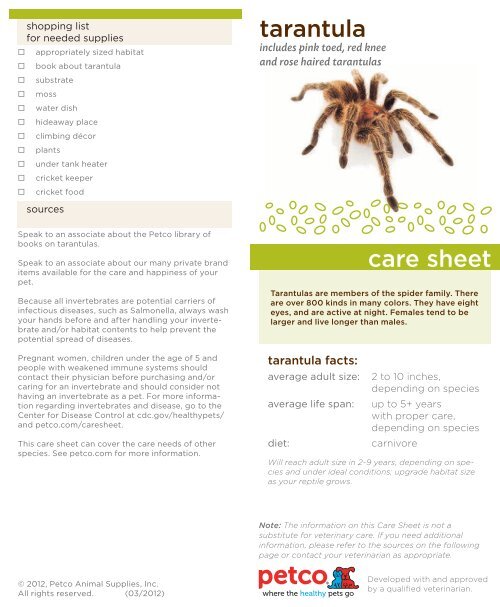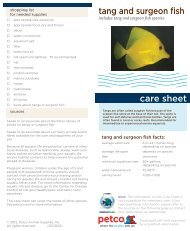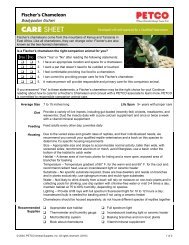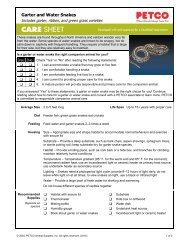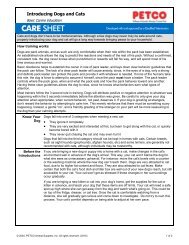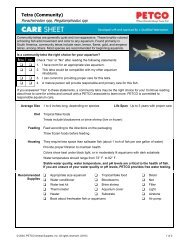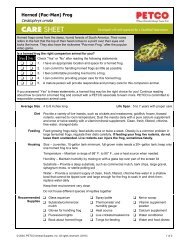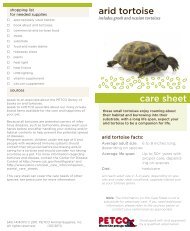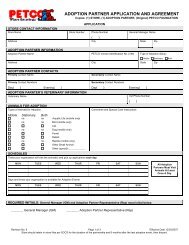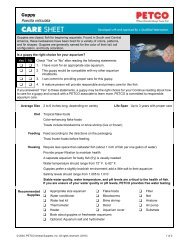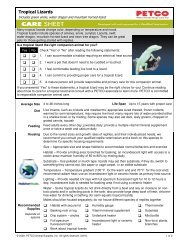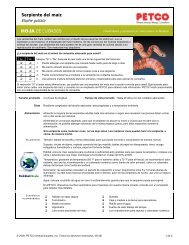tarantula care sheet - Petco
tarantula care sheet - Petco
tarantula care sheet - Petco
Create successful ePaper yourself
Turn your PDF publications into a flip-book with our unique Google optimized e-Paper software.
shopping listfor needed supplies appropriately sized habitat book about <strong>tarantula</strong> substratemosswater dishhideaway placeclimbing décorplantsunder tank heatercricket keepercricket foodsources<strong>tarantula</strong>includes pink toed, red kneeand rose haired <strong>tarantula</strong>sSpeak to an associate about the <strong>Petco</strong> library ofbooks on <strong>tarantula</strong>s.Speak to an associate about our many private branditems available for the <strong>care</strong> and happiness of yourpet.Because all invertebrates are potential carriers ofinfectious diseases, such as Salmonella, always washyour hands before and after handling your invertebrateand/or habitat contents to help prevent thepotential spread of diseases.Pregnant women, children under the age of 5 andpeople with weakened immune systems shouldcontact their physician before purchasing and/orcaring for an invertebrate and should consider nothaving an invertebrate as a pet. For more informationregarding invertebrates and disease, go to theCenter for Disease Control at cdc.gov/healthypets/and petco.com/<strong>care</strong><strong>sheet</strong>.This <strong>care</strong> <strong>sheet</strong> can cover the <strong>care</strong> needs of otherspecies. See petco.com for more information.<strong>tarantula</strong> facts:average adult size:average life span:diet:<strong>care</strong> <strong>sheet</strong>Tarantulas are members of the spider family. Thereare over 800 kinds in many colors. They have eighteyes, and are active at night. Females tend to belarger and live longer than males.2 to 10 inches,depending on speciesup to 5+ yearswith proper <strong>care</strong>,depending on speciescarnivoreWill reach adult size in 2-9 years, depending on speciesand under ideal conditions; upgrade habitat sizeas your reptile grows.Note: The information on this Care Sheet is not asubstitute for veterinary <strong>care</strong>. If you need additionalinformation, please refer to the sources on the followingpage or contact your veterinarian as appropriate.© 2012, <strong>Petco</strong> Animal Supplies, Inc.All rights reserved. (03/2012)Developed with and approvedby a qualified veterinarian.
<strong>care</strong> <strong>sheet</strong><strong>tarantula</strong>includes pink toed, red knee androse haired <strong>tarantula</strong>sDeveloped with and approvedby a qualified veterinarian.dietA well-balanced <strong>tarantula</strong>diet consists of:• Appropriate size liveinsects, such as gutloaded(recently fed)crickets, mealworms,superworms, roaches.• Some species may eatfrozen/thawed pinkiemice, thawed/warmedto room temperature.feedingThings to rememberwhen feeding your <strong>tarantula</strong>:• Fresh, clean, chlorinefreewater should beavailable at all times;may not drink from abowl but will rely onmoisture on plants.• Feed juveniles severaltimes a week; adultsonce a week.• Be sure that foodis smaller than the<strong>tarantula</strong>; pink-toes eatsmall crickets; removeany uneaten live foodas it may cause injuryto a resting <strong>tarantula</strong>.housing• Size - appropriate sizeand shape habitat toaccommodate normalbehavior and exercise;at least three timesthe leg-span longand two times theleg-span wide. Heightshould be the lengthof the <strong>tarantula</strong> forground dwellers, about10 inches for treedwelling<strong>tarantula</strong>s.• Habitat - provide aplace to hide, such as ahalf log; tree-dwelling<strong>tarantula</strong>s also needtwigs and branchesto build their webs.Maintain 50-90%humidity by misting asneeded every day.• Substrate - mulchtypesuch as coconutfiber bedding, reptilebark or dampenedsphagnum moss; avoidgravel and artificial turf(too harsh for skin).• Temperature - 70-82°F.• Lighting - keep in adarker part of the roomaway from sunlight;avoid incandescentlights which can dryout a <strong>tarantula</strong>; usea black or infraredlight to watch your<strong>tarantula</strong> after dark.Water - always have ashallow dish of fresh,de-chlorinated water.• House <strong>tarantula</strong>sseparately and donot house differentinvertebrate speciestogether.normalbehavior• Handling <strong>tarantula</strong>sis not recommended;if feeling threatened,they may bite or evenrun and fall. Even ashort fall can causeserious, even fatalinjury.• Their bite is equivalentto a bee sting but isstill painful and someindividuals may beespecially sensitive; ifbitten, seek immediatemedical attention.• As part of their naturaldefense, some may“flick” defense hairswhich may also causeallergic reaction orirritation.habitatmaintenance• No special cleaningrequired; spray-mistthe habitat as neededto keep the habitatmoist; <strong>tarantula</strong>s needthe correct humidity tostay healthy.• Fill water bowl daily.grooming& hygieneWhen <strong>tarantula</strong>s molt,they lie on their backwith their feet up in theair; juveniles molt aboutfour times a year andadults once a year. Maystop eating up to twoweeks before a molt; donot disturb during thistime. Be sure to removeall live food from enclosureas even a cricketcould harm them duringthis period.signs of ahealthy animal• Eats regularly• Healthy skin or shell(exoskeleton)• Active and alertred flags• dull shell(exoskeleton)• bleeding from injuryto leg or abdomen• very slowmovements• getting stuck in amoltcommon health issuesHealth Issue Symptoms or Causes Suggested Actiondehydrationslow moving, shriveledappearance.consult your exoticanimal veterinarianand spray-mistthe habitat morefrequently.falls, injuries bleeding immediately consultyour exotic animalveterinarian.If you notice any of these signs, please contact yourexotic animal veterinarian.


